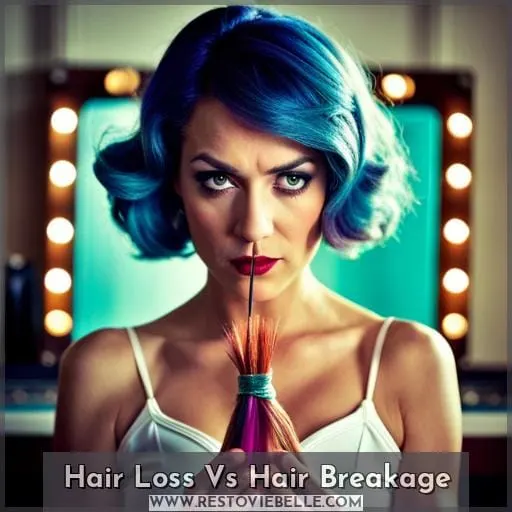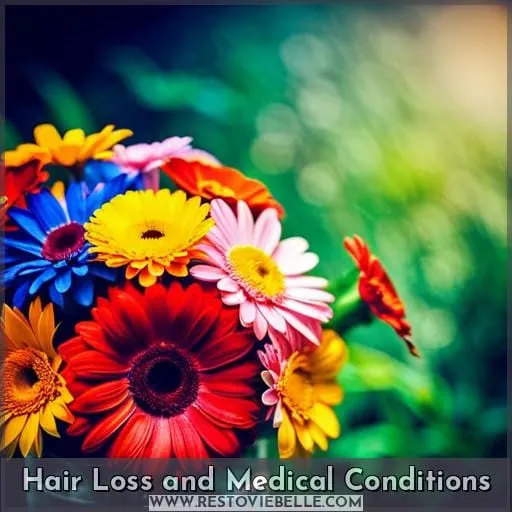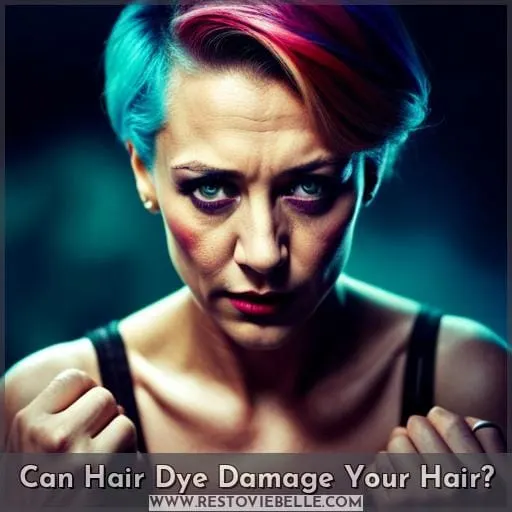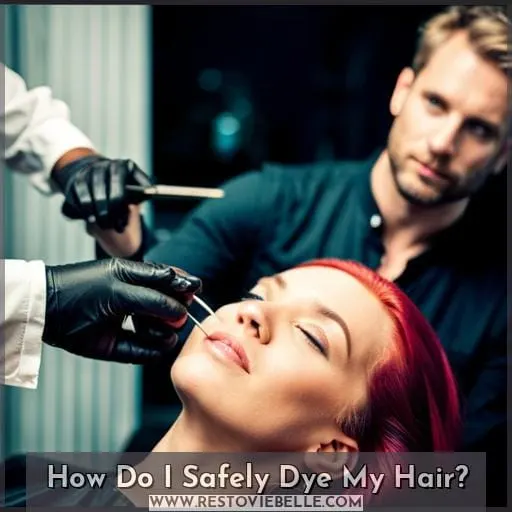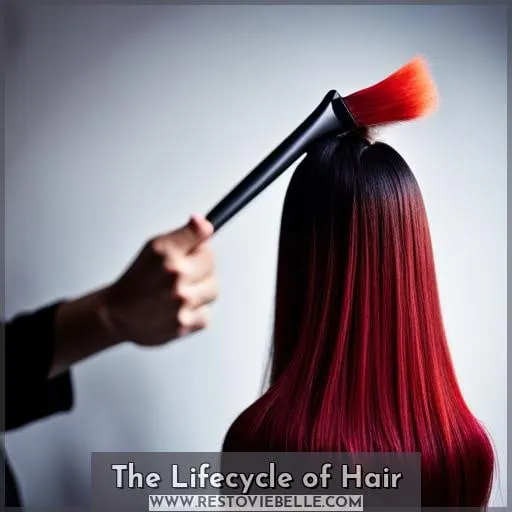This site is supported by our readers. We may earn a commission, at no cost to you, if you purchase through links.
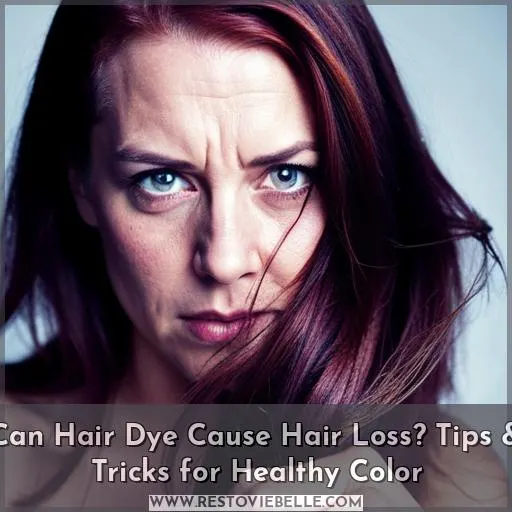 Curious about whether hair dye can cause hair loss? While it’s true that some chemicals used in the coloring process can be damaging to your locks, there are several steps you can take to ensure a healthy color without sacrificing those precious strands.
Curious about whether hair dye can cause hair loss? While it’s true that some chemicals used in the coloring process can be damaging to your locks, there are several steps you can take to ensure a healthy color without sacrificing those precious strands.
Read on for tips and tricks on how to achieve your desired hue safely and keep your crowning glory looking its best.
From understanding the differences between hair loss versus breakage, recognizing potential medical conditions that could lead to thinning, as well as learning ways of minimizing damage from harsh ingredients like peroxide or ammonia – this guide will provide all the information you need when considering dyeing your tresses!
Table Of Contents
Key Takeaways
- Hair dyeing can potentially cause hair loss due to the harsh chemicals present in the dyes.
- It is important to distinguish between hair loss and hair breakage when addressing dyeing-related hair issues.
- Proper precautions and maintenance, such as using quality products and deep conditioning, can help minimize damage caused by hair dyeing.
- Natural alternatives like henna and vegetable dyes offer a safer option for those concerned about the chemical risks of hair dyeing.
Hair Loss Vs Hair Breakage
You might be wondering if hair dye can cause hair loss, but it’s important to understand the difference between shedding and breakage due to dyeing. Permanent dyes alter the protein in the shaft of your hair, making them prone to damage or breakage when not cared for properly.
Temporary, semi-permanent, demi-permanent, and permanent dyes all have varying effects on scalp health depending on their application and maintenance. Bleaching or lightening with hydrogen peroxide weakens the cuticles, which can lead to split ends down the line.
Deep conditioning is essential after dyeing sessions, so make sure you give yourself time off from color treatments every once in a while. This will help prevent any unpleasant side effects like increased shedding or a gummy texture from forming over time.
Consulting a professional stylist who understands how different types of chemical reactions affect scalp health is also an option if there are any concerns about potential damage caused by frequent coloring processes.
Can Hair Dye Cause Hair Loss?
You may be wondering if hair dye can cause hair loss. It’s important to understand the difference between normal shedding and actual medically-related hair loss, as well as the effects of chemicals on your overall hair health.
Hair shedding is a natural process that occurs when ready-to-shed hairs are dislodged due to scalp manipulation during dye application or chemical exposure from dyes and lighteners. On the other hand, true alopecia involves root shedding with visible bulbs, while breakage lacks these bulbs entirely.
Hair Shedding Vs. Hair Loss
Shedding and loss may look similar, yet they differ in subtle ways; so let’s take a closer peek. Hair shedding is natural and occurs when hair has reached its end-of-life cycle, whereas hair loss involves root shedding with an attached visible bulb.
Color choices, scalp health, and dyeing techniques can all affect the amount of damage to your strands, which could cause thinning or fall out prematurely due to breakage.
Effects of Chemicals on Hair Health
Chemicals present in hair dye can damage the protective layers of your hair, making it vulnerable to breakage and loss. Chemical reactions between different agents, such as hydrogen peroxide or lightening agents, can be particularly damaging if not done safely.
The excess chemicals used in dyes break down proteins that protect the hair shaft, leading to weak strands and increased shedding if not properly maintained. As a result, using high-quality products and following instructions is essential for preventing side effects like split ends or excessive shedding due to chemical damage from dyeing your hair.
With proper protection during application and maintenance afterward, you’ll help keep your locks healthy!
Hair Loss and Medical Conditions
You may have heard of hair dye and its potential to cause hair loss, but there is much more to the story. Alopecia, a medical condition which causes baldness or thinning of the scalp’s hair follicles, as well as underlying health issues, can all be linked with increased levels of shedding and even complete baldness.
Understanding how these conditions interact with your body can help you make informed decisions about coloring or treating your locks for optimal results.
Alopecia and Hair Loss
Alopecia is a medical condition that can cause hair loss. It’s important to differentiate from normal shedding due to growth-rest cycles. Being mindful about your hair health now helps prevent bigger problems down the road.
Alopecia causes include thyroid disease, cancer treatments, and autoimmune responses, all of which require professional medical treatment for effective management. Dye maintenance also plays into protection; use gloves and follow directions correctly while avoiding prolonged exposure and bleaching agents like hydrogen peroxide or ammonia.
Consider deep conditioning after dyeing for extra scalp protection as well as color-safe products going forward for optimal results.
Underlying Medical Conditions and Hair Loss
It’s important to consider any underlying medical conditions that could be contributing to your hair loss. An immune system disorder, hormone imbalance, scalp infections, or stress levels can lead to thinning and shedding of hair.
Vitamin deficiencies may also reduce the protein structure in the shaft, leading to breakage and falling strands. If you suspect a hormone issue is causing your alopecia, consult a board-certified dermatologist for proper diagnosis and treatment options.
You can try wake up call volumizing shampoo or conditioner, which can help strengthen weakened follicles from within.
Can Hair Dye Damage Your Hair?
You may be wondering if hair dye can cause damage to your hair. Hair dye products contain chemicals, such as ammonia and peroxide, which can damage the outer layer of the hair shafts, leading to breakage and split ends.
Aside from that, frequent use of these dyes also weakens the structure of each strand, making it more susceptible to shedding. It is important, therefore, for you to understand how best to protect your tresses when using hair dye products.
Potential Damage From Hair Dye
Frequent coloring can put your tresses at risk of shedding when done too often, so it’s best to be mindful. Hair dyeing comes with risks like weakened hair shafts due to ammonia and hydrogen peroxide in permanent dyes, as well as breakage from mechanical manipulation during application.
To reduce damage, stick to one brand and color mix for consistent results. Wear gloves and use deep conditioning after dyeing. If you’re looking for protection while still achieving the desired effect, opt for semi-permanent color over other types.
Effects of Ammonia and Peroxide on Hair Shaft
Chemicals such as ammonia and peroxide can weaken the hair shafts, making them prone to breakage when dyeing your hair. Scalp manipulation during bleaching or coloring further damages color-treated tresses.
Hydrogen peroxide is a common bleaching agent used in dyes, which corrodes proteins in the cuticles, leading to weakened strands and increased shedding from aging or thinning locks. Professional advice is essential for the safe use of chemicals found in hair dyes.
Deep conditioning afterwards provides additional protection against potential damage caused by these agents.
How Do I Safely Dye My Hair?
It is important to understand the risks associated with hair dyeing and how best to protect your hair when coloring. Seeking professional guidance for your individual needs, as well as following tips for safe home dyeing, can help you make an informed decision about dyeing your hair without risking damage or loss of healthy strands.
By taking these precautionary measures, you will be able to enjoy vibrant color that lasts while keeping your locks looking gorgeous and healthy.
Professional Guidance for Hair Dyeing
Getting the right advice from a professional can help take your hair dyeing to the next level and keep you on track for healthy, vibrant locks. Follow their guidance: wear gloves, protect surfaces from staining, and watch out for gummy texture or increased shedding.
Go for color-safe products when maintaining dyed locks; deep conditioning is especially important after coloring hair. For those with thinning/aging or curly hair types, consider tailored approaches to prevent prolonged exposure.
So avoid experimenting too much and stick to one brand & color in order to get consistent results without compromising safety standards; it’s key in keeping your tresses looking gorgeous while protecting them against damage caused by dyes.
Tips for Safe Dyeing at Home
When dyeing your hair at home, follow professional guidance to ensure the best results and maintain healthy locks. Wear protective gloves when handling dyes and select colors with care. Avoid scalp manipulation for temporary or demi-permanent color applications; use salon brands of bleach or lighteners instead.
Protect hair from heat damage by using a deep conditioning product before styling, then choose a brand specifically formulated for your desired color result. Lastly, monitor signs of breakage such as increased shedding or split ends after each treatment – if necessary, consult a dermatologist about any medical concerns related to hair loss.
The Lifecycle of Hair
Understanding the lifecycle of your hair is essential to knowing if dyeing it can cause hair loss. There are three phases in a normal hair cycle: Anagen, Catagen, and Telogen. The telogen phase may lead to Telogen Effluvium, where one experiences increased shedding due to stress or trauma on the scalp.
Knowing this information is key to making informed decisions when it comes to safely dyeing your own hair.
Anagen, Catagen, and Telogen Phases
Understanding the anagen, catagen, and telogen phases of hair growth can help you make informed decisions about dyeing your locks for long-lasting results.
The first stage is anagen, where new hairs grow from follicles. If you’re looking to maintain healthy color vibrancy or add volume with a semi-permanent color option, it’s best done during this phase.
Next up is the catagen phase: when hair stops growing and begins transitioning into dormancy before shedding in the final telogen stage.
To minimize damage and prevent excessive shedding, choose quality dyes like those free of ammonia or peroxide that won’t weaken follicle proteins responsible for renewal processes between each cycle!
Telogen Effluvium and Hair Shedding
You may experience more shedding than usual if you’re coloring your hair often, as this can lead to chronic Telogen Effluvium. This form of hair loss occurs when the scalp is exposed to frequent chemical or mechanical manipulation.
Hair dyeing and scalp manipulation can cause breakage due to weakened proteins in treated strands.
Frequently Asked Questions (FAQs)
Are there any natural alternatives to hair dye?
Yes! Natural alternatives to hair dye are available, including henna and vegetable dyes. These provide vibrant color while protecting your hair from harsh chemicals or damaging bleaching agents. Discover the perfect option for you and enjoy healthier, beautiful locks without sacrificing your style.
How often should I dye my hair?
Dye your hair as often as you are comfortable with, but be sure to use quality products and follow professional instructions. Take care not to expose your hair for too long or over-process it, which can cause damage and lead to breakage.
Is it safe to dye my hair during pregnancy?
While the safety of hair dye during pregnancy isn’t definitively known, it’s generally accepted that semi-permanent dyes are safer than permanent ones. You may want to consult your physician before making a decision; after all, the health of you and your unborn baby should be the top priority! And don’t forget to deep condition afterward—it’ll help keep those locks healthy no matter what color they become.
Are there any special precautions I should take when dyeing my hair?
To ensure the best results, always follow professional guidance when dyeing your hair. Use gloves and be sure to protect surfaces from staining. Look out for a gummy texture or increased shedding, and deep condition after coloring.
Is there any way to reduce hair loss related to hair dye?
To reduce hair loss due to dyeing, follow professional guidance and use high-quality dyes. Avoid prolonged exposure and consistent mixing of colors. Wear gloves to protect your scalp and choose color-safe products for maintenance.
Talk with a dermatologist if you’re experiencing unexplained hair loss for tailored advice on how best to care for your hair.
Conclusion
It’s no secret that hair dye can be a great way to transform your look, but it’s important to understand the potential effects it can have on your hair. Hair dyeing can cause breakage and even hair shedding, which can be mistaken for hair loss.
While hair dyeing itself can’t penetrate the scalp and cause hair loss, certain ingredients like ammonia and peroxide can damage the hair shaft and increase the risk of shedding.
To safely dye your hair, it’s recommended to get professional advice and to take extra care when dyeing at home. By following hair dyeing instructions, using quality products, and taking breaks between treatments, you can maintain healthy hair and color while minimizing the risk of hair loss.
